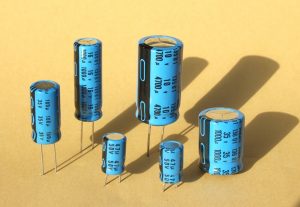Points of Discussion
A. Definition of Electrolytic Capacitor and Overview
B. Family Tree of Electrolytic Capacitors
C. Principle of charge
D. Construction of Capacitor
E. Capacitance and volumetric efficiency
F. Electrical characteristics
G. Symbol of capacitor
Electrolytic Capacitor
Definition
“An electrolytic capacitor can be defined as the capacitor which metal ended anodes. This anode creates an insulating oxide layer.”
The insulating oxide layer functions as a dielectric layer of the capacitor. The oxide layer is roofed by concrete, liquid, or gel electrolytes. This roofed part serves as the cathode of the electrolytic capacitor.
Electrolytic Capacitor Polarity
Symbol of capacitor
Electrolytic capacitors have specific symbol. The symbol in the circuit, let us understand which type of capacitor is this.


A typical Electrolytic capacitor has a higher capacitance-voltage (CV) product per unit volume in comparison to other types. The feeble dielectric layer as well as the broader anode surface helps to achieve that.
Types of Electrolytic capacitors
They have three kinds –
- Aluminum type Capacitors
- Tantalum type Capacitors
- Niobium type Capacitors
This type of capacitor has a large capacitance, which helps them bypass low-frequency signals and store a large number of energies. They find applications in decoupling and filtering circuits.
These types of capacitors are polarized. The reason behind them is their special structure. They must be operated at higher voltages, and more positive voltages should be on the anode and cathode.
The anode of an industrial usable electrolytic capacitor is marked with a plus sign. An electrolytic capacitor can be destroyed by applying a reverse polarity voltage or using an excessive voltage than the rated working voltage. The destruction is hazardous and can create an explosion to fire.
Bipolar electrolytic capacitors is also one of its kind. It can be formed simply by joining two capacitors by connecting anodes to anode and cathode to cathode.
Know about other types of Capacitors & Workings
Family Tree of Electrolytic Capacitors
Electrolytic capacitors have several varieties. The nature of the positive plate and the type of electrolytic used makes the variation. Each of these three types of capacitors uses concrete and non-solid kinds of electrolytes. The tree is shown below –

Principle of charge
This capacitors stores energy just like regular capacitors. It holds power by parting charge in an electrical field in the insulating oxide layer inside the conductors. An Electrolyte is present here, which acts as the cathode. It also forms another electrode of the capacitor.
Construction
These capacitors practice a chemical property of “Valve metals” to create the capacitor. The practice creates a thin layer of oxide when interchanges with a certain type of electrolyte. There are three solid kinds that are practiced as anode in these capacitors.
1. Aluminium – This type of capacitors uses a high purity imprinted aluminium foil with aluminium oxide as the dielectric material.
2. Tantalum – This type of capacitors use tantalum dust which has lowest level of doping.
[ Read About Tantalum Capacitor. Click Here! ]
3. Niobium – This type of capacitors uses a niobium dust pellet which has lowest level of doping.
The property of the anode materials can be studied below –
| Material | Dielectric Material | Structure of oxide | Permittivity | Breakdown Voltage(V/µm) |
| Aluminum | Aluminum Oxide [Al2O3] | Amorphous | 9.6 | 710 |
| Aluminum | Aluminum Oxide [Al2O3] | Crystalline | 11.6-14.2 | 800-1000 |
| Tantalum | Tantalum pentoxide [Ta2O5] | Amorphous | 27 | 625 |
| Niobium | Niobium pentoxide [Nb205] | Amorphous | 41 | 400 |
We can see that the permittivity of tantalum oxide is three-time more than Aluminium oxide.
Every anode is imprinted with less smooth cover area and has a larger cover area compared to a smothering one. This is done to increase the capacitance per unit volume of the capacitor.
If a positive valued potential is applied across the capacitor’s anodes, a thick oxide barrier layer will be formed. The thickness of the coating area depends upon the applied voltage over the anodes. This oxide layer which is insulator as well, then functions as a dielectric material. The oxide layer generated by the anode can be destroyed if the applied voltage’s polarity is reversed.
After the dielectric formation, a counter needs to match the rough insulating area on which the oxide formed. As the electrolyte acts as a cathode, it accomplishes the matching process.
Electrolytes are categorized mainly in two sections – ‘Solid’ and ‘Non-Solid.’ Liquid mediums with ion conductivity by moving ions are considered non-solid electrolytes. This type of electrolytes can be easily fit on a rough surface. Solid ones work in the rugged structure by using chemical processes like – polymerization for conducting polymers or pyrolysis for manganese dioxide.
Electrolytic Capacitors Capacitance and volumetric efficiency
The working principle of an electrolytic types capacitor is similar as the working of ‘plate capacitor.’
Capacitance is represented by the following equation.
C = ε*(A /d)
Here,
C is the capacitance.
A is the area of the plates.
d is the distance between two plates.
ε is the Permittivity of the medium between two plate.
Increasing the electrode area and the dielectric permittivity will increase the Capacitance.
If we look in detail, an electrolytic types capacitor has a weak dielectric layer, and it stays in the boundary of nanometre per volt. There is another reason behind the higher capacitance. It is the rough surface area.
Electrical characteristics
Series equivalence circuitry
The characteristics of electrolytic capacitors is well defined in ‘International generic description IEC 60384-1’. The capacitors can be represented as a flawless corresponding circuit with series connection of electrical components, including all the ohmic losses, capacitive, inductive parameters of an electrolytic capacitor.
The below circuit represents the series equivalent of Electrolytic Capacitors

C represent the capacitance value of the capacitor; RESR represents the series equivalent resistance. Losses due to heat and ohmic effects are also taken into considerations. LESL is the corresponding inductance in series and considered as the self-inductance of the electrolytic capacitor. Bleak is the leakage resistance.
The Capacitance, Standard Values, and Tolerances Parameter of Electrolytic Capacitor
The construction of anode and cathode primarily decides the characteristics of an electrolytic capacitor. The capacitance value of a capacitor is dependent on some factors like the temperature parameters and the frequency. Electrolytic capacitors of non-solid types have a property of deviation towards temperatures. It shows more deviation than solid types of electrolytes.
The unit of the capacitance is typically in microfarad (µF).
- The needed acceptance value of capacitance is determined by the specified applications.
- Electrolytic capacitors do not require the narrow tolerances.
Ready and Category voltage
Rated voltage of Electrolytic capacitor is defined as the voltage at which the capacitor works with full efficiency. If the capacitor is supplied more than the rated voltage the capacitor gets damaged.
If a capacitor is supplied lower voltage than the rated level, it also effects the capacitor. Applying of lower voltages increase the life of the capacitor. Sometimes it increases reliability for tantalum electrolytic capacitors.
Surge Voltage
Surge voltage is the maximum amount of peak voltage that is supplied to the electrolytic capacitors. It is calculated for the period of the capacitor’s usage in a limited number of cycles.
Transient voltage
Electrolytic capacitors which has Aluminium as material has a tendency to show less sensitivity towards transient voltages.
This condition contents only if the frequency and the energy of the transient is comparatively less.
Reverse voltage
A typical electrolytic capacitor is polarized and, in general, entails the anode electrode voltage to be positive in respect to the cathode voltage.
The reverse voltage is seldom used in fixed AC circuits.
Impedance
A typical capacitor is used as a storage component of electrical energy. Sometimes a capacitor is placed to act as a resistive element in an AC circuit. The major application of an electrolytic capacitor is the decoupling capacitor.
Impedance of a capacitor is given by the AC resistance which is frequency dependent and has phase and magnitude at a specified frequency.
To know more about Capacitor click here
For more Electronics related article click here

Hi, I am Sudipta Roy. I have done B. Tech in Electronics. I am an electronics enthusiast and am currently devoted to the field of Electronics and Communications. I have a keen interest in exploring modern technologies such as AI & Machine Learning. My writings are devoted to providing accurate and updated data to all learners. Helping someone in gaining knowledge gives me immense pleasure.
Let’s connect through LinkedIn –